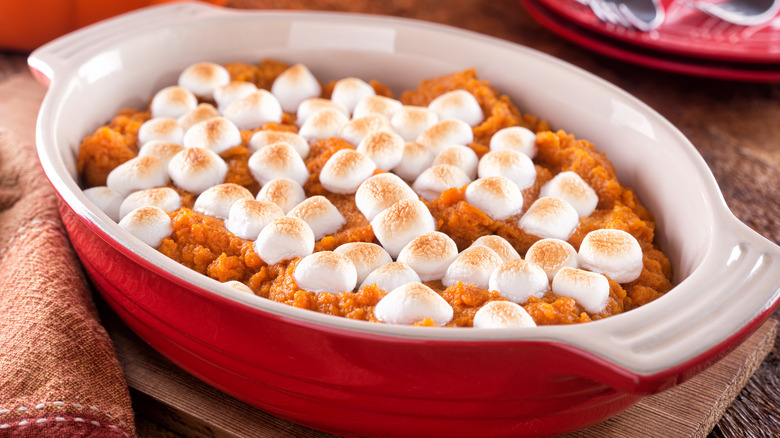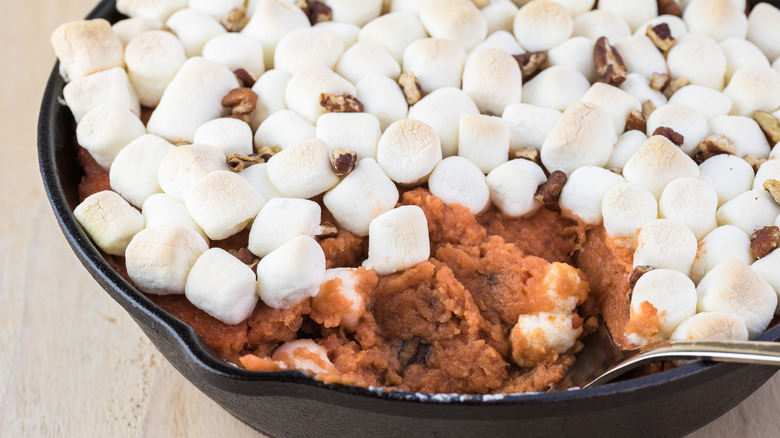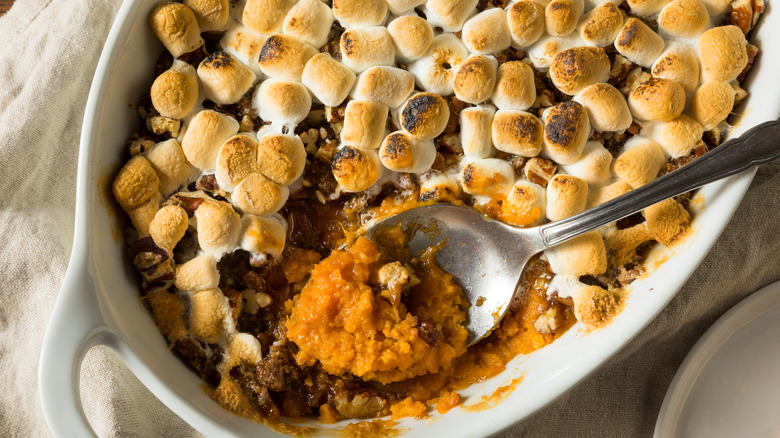What's The Best Way To Freeze Sweet Potato Casserole?
Soft, cooked sweet potatoes, gooey marshmallows, crunchy pecans, and lots of melted butter. Mix them together and you have a favorite holiday side dish: sweet potato casserole. Whether you're planning on baking and storing this treat ahead of time for a party or you've made a bigger meal than you were planning on and have leftovers, you may be wondering whether it's possible to freeze your sweet potato casserole. The answer is yes — though there are some guidelines to follow to ensure it freezes well.
The absolute best way to freeze sweet potato casserole, to start, requires you to cook the sweet potatoes before freezing. Freezing an unbaked casserole will yield disastrous results; raw sweet potatoes are full of water, and freezing them can burst their cells and render them a watery mess when removed from cold storage.
If at all possible, you should also freeze the cooked casserole and topping separately. Most ingredients that you might find on top of this type of casserole, including marshmallows, nuts, and even other crunchy additions like cornflakes, don't freeze very well. That's especially true when in contact with wetter foods that will moisten them in the freezer (like those soft, cooked sweet potatoes). Prepare that part separately and place it in its own container, like a plastic zipper bag. You can also make the topping the day you plan on serving the casserole if you want it to be extra fresh.
Tips for frozen casserole success
To prepare a sweet potato casserole for the freezer, follow all of the instructions in your recipe up to the moment when it calls for you to add the topping. Allow the casserole to cool completely. If you transfer the casserole directly to the freezer while still hot, you create a risk of bacteria and illness.
Place a strip of parchment over the top of the casserole in the dish you baked it in. You can freeze the casserole directly in the pan, saving you time and reducing the number of used dishes when you're ready to reheat it later. Cover everything in tinfoil (twice, if you can manage it; double-wrapping will help you escape the process that leads to freezer burn). Then make doubly sure to label the casserole with any timely notes such as the date it was frozen, the bake time and temperature, the topping ingredients (if you're planning on whipping up the topping later), and anything else that might be helpful to know later on.
Defrosting and baking a frozen sweet potato casserole
After going through the process of perfectly freezing your casserole, you'll want to take care to heat it back up properly so it's just as delicious as when it was first made. This starts with defrosting the casserole (and toppings, if applicable) in the fridge. Allow it to come to temperature over a 24-hour period if possible. If your casserole contains eggs of any sort, this is an especially important step.
When you're ready to bake, remove the casserole from the fridge and allow it to come to room temperature. A fast temperature change from the fridge to the oven can cause thermal shock, leading to a cracked pan, so avoid putting the cold casserole directly into the heat.
At this point, you can simply bake your casserole according to the original recipe's instructions. Add the topping as directed, watch it brown and bubble in the oven, and prepare to serve when it's ready.


